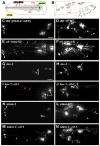The CIL-1 PI 5-phosphatase localizes TRP Polycystins to cilia and activates sperm in C. elegans
- PMID: 19781942
- PMCID: PMC2762383
- DOI: 10.1016/j.cub.2009.08.045
The CIL-1 PI 5-phosphatase localizes TRP Polycystins to cilia and activates sperm in C. elegans
Abstract
Background: C. elegans male sexual behaviors include chemotaxis and response to hermaphrodites, backing, turning, vulva location, spicule insertion, and sperm transfer, culminating in cross-fertilization of hermaphrodite oocytes with male sperm. The LOV-1 and PKD-2 transient receptor potential polycystin (TRPP) complex localizes to ciliated endings of C. elegans male-specific sensory neurons and mediates several aspects of male mating behavior. TRPP complex ciliary localization and sensory function are evolutionarily conserved. A genetic screen for C. elegans mutants with PKD-2 ciliary localization (Cil) defects led to the isolation of a mutation in the cil-1 gene.
Results: Here, we report that a phosphoinositide (PI) 5-phosphatase, CIL-1, regulates TRPP complex ciliary receptor localization and sperm activation. cil-1 does not regulate the localization of other ciliary proteins, including intraflagellar transport (IFT) components, sensory receptors, or other TRP channels in different cell types. Rather, cil-1 specifically controls TRPP complex trafficking in male-specific sensory neurons and does so in a cell-autonomous fashion. In these cells, cil-1 is required for normal PI(3)P distribution, indicating that a balance between PI(3,5)P2 and PI(3)P is important for TRPP localization. cil-1 mutants are infertile because of sperm activation and motility defects. In sperm, the CIL-1 5-phosphatase and a wortmannin-sensitive PI 3-kinase act antagonistically to regulate the conversion of sessile spermatids into motile spermatozoa, implicating PI(3,4,5)P3 signaling in nematode sperm activation.
Conclusion: Our studies identify the CIL-1 5-phosphatase as a key regulator of PI metabolism in cell types that are important in several aspects of male reproductive biology.
Figures





References
-
- Di Paolo G, De Camilli P. Phosphoinositides in cell regulation and membrane dynamics. Nature. 2006;443:651–657. - PubMed
-
- Barr MM, Sternberg PW. A polycystic kidney-disease gene homologue required for male mating behaviour in C. elegans. Nature. 1999;401:386–389. - PubMed
-
- Barr MM, DeModena J, Braun D, Nguyen CQ, Hall DH, Sternberg PW. The Caenorhabditis elegans autosomal dominant polycystic kidney disease gene homologs lov-1 and pkd-2 act in the same pathway. Curr Biol. 2001;11:1341–1346. - PubMed
-
- Igarashi P, Somlo S. Genetics and pathogenesis of polycystic kidney disease. J Am Soc Nephrol. 2002;13:2384–2398. - PubMed
Publication types
MeSH terms
Substances
Grants and funding
LinkOut - more resources
Full Text Sources
Molecular Biology Databases
Research Materials
Miscellaneous

